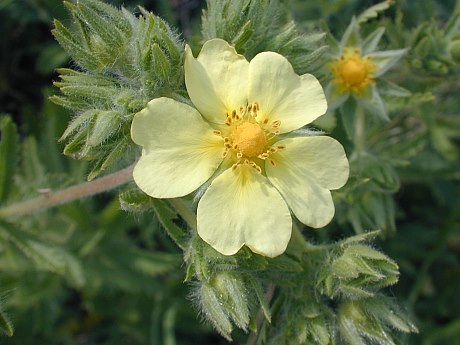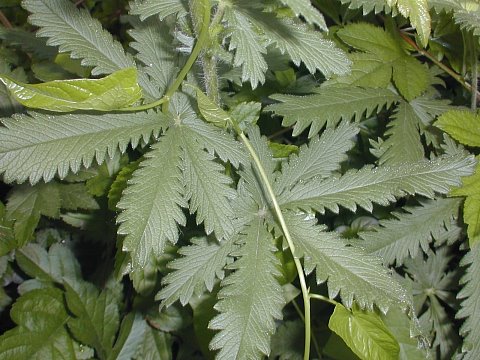Description: Initially, this perennial plant develops a few basal leaves on long petioles. By late spring, this plant bolts to become 1–2½' tall, branching frequently along the upper one-third of its length. At this stage of development, it is more or less erect in habit, rather than sprawling or stoloniferous. The terete stems are light green, light reddish green, or nearly white; they are hairy while young, becoming less hairy with age. The hairs of these stems are long, white, and spreading. There are alternate leaves distributed along the entire length of these stems, becoming smaller in size as they ascend. These leaves are palmately compound. The lower leaves have 5-9 leaflets and long petioles, while upper leaves have 3-5 leaflets and either short petioles or they are sessile. Sometimes the uppermost leaves underneath the flowers have only 2 leaflets or they are simple. Individual leaflets are 1¼–3½" long and ¼–¾" across; the middle leaflets are larger in size than the lateral leaflets. The leaflets are elliptic to oblong-oblanceolate in shape, very coarsely toothed along their margins, and sessile. The upper surface of leaflets is green to grayish green and glabrous to sparsely appressed-hairy, while the lower surface of leaflets is light green, spreading-hairy along their central veins, and glabrous to sparsely appressed-hairy elsewhere. The petioles are up to 5" long, light green to nearly white, terete, and spreading-hairy. Leaflet venation is pinnate.

The upper stems terminate in flat-topped clusters of flowers. Each flower is about ¾" across, consisting of 5 pale yellow to yellow petals, 5 hairy green sepals, 25 to 30 stamens with yellowish anthers, and a bright yellow receptacle with numerous pistils. The spreading petals are obcordate, while the sepals are deltate; the petals are a little longer than the sepals. Directly underneath the sepals of each flower, there are 5 linear to linear-lanceolate bractlets that are green and hairy. The branching stalks of the inflorescence and the short pedicels of the flowers are light green to light reddish green, terete, and short-pubescent to spreading-hairy. At the base of floral stalks, there are usually hairy green bracts less than 1" in length. The blooming period usually occurs from early to mid-summer, lasting about one month. Each flower produces a dense cluster of dark brown seeds about 1 mm. in length or slightly longer; these seeds are somewhat flattened and finely reticulated with light brown ridges. The root system of a mature plant consists of a slightly woody crown with coarse fibrous roots underneath; sometimes multiple stems develop from the crown. This plant reproduces by reseeding itself.

Cultivation:
The
preference is partial to full sun, mesic to dry conditions, and soil
containing loam, clay, sand, or gravel. This plant is quite tolerant of
alkaline soil. Individual plants typically live for 1-10 years. The
seeds can germinate the same year in which they are produced, or they
can persist in the ground for at least 3 years and remain viable.
Range & Habitat:
The non-native Sulfur Cinquefoil is a common plant that occurs in most
counties of Illinois (see Distribution
Map). It was accidentally introduced into North America from
Eurasia. Habitats include limestone glades, pastures and abandoned
fields, vacant lots, roadsides, gravelly areas along railroads,
compacted soil
along grassy paths or dirt roads, infrequently mowed
lawns, weedy meadows, and waste areas. This plant prefers
disturbed open areas with alkaline soil.

Faunal Associations: The nectar and pollen of the flowers attract Halictid bees, masked bees (Hylaeus spp.), Andrenid bees, Syrphid flies, small butterflies, and beetles (Reed, 1993; other sources). Various aphids reportedly suck the sap of Sulfur Cinquefoil and other Potentilla spp. (Cinquefoil species), including Acyrthosiphon malvae (Geranium Aphid), Chaetosiphon fragaefolii (Strawberry Aphid), and Macrosiphum pallidum (Pepper, 1965; Blackman & Eastop, 2013). Other insects that feed on these plants include larvae of Neolasioptera potentillaecaulis (Cinquefoil Stem Gall Midge), larvae of Diastrophus potentillae (Cinquefoil Axil Gall Wasp) and Diplolepis fusiformans (Cinquefoil Stem Gall Wasp), larvae of the sawflies Empria maculata and Fenella nigrita, and leaf-mining larvae of the moth Tinagma obscurofasciella (Felt, 1917; Smith, 2006; Microleps website, 2010). Some polyphagous grasshoppers also feed on these plants, including Melanoplus borealis (Northern Grasshopper) and Melanoplus bruneri (Bruner's Grasshopper); Brust et al. (2008). Because of the high tannin content of the leaves, most mammalian herbivores browse on Sulfur Cinquefoil and other cinquefoils to only a limited extent. As a result, Sulfur Cinquefoil is considered an 'increaser' in cattle pastures. However, there is some evidence that White-tailed Deer and Cottontail Rabbits browse on the foliage occasionally (Sotala & Kirkpatrick, 1973; Martin et al., 1951/1961). There is also some evidence that the seeds can pass through the digestive tracts of White-tailed Deer and remain viable (Myers et al., 2004). This spreads the seeds to new locations. Ruffed Grouse also browse on the foliage of cinquefoils. The seeds are eaten to a minor extent by the American Woodcock, Prairie Deer Mouse, and House Mouse (Martin et al., 1951/1961; Houtcooper, 1978; Whitaker, 1966).

Photographic
Location:
An overpass containing shallow gravelly soil along a railroad
in Urbana, Illinois, and gravelly soil along a railroad in the same
city.
Comments:
Sulfur Cinquefoil has reasonably attractive flowers and foliage. The
latter has some superficial resemblance to the foliage of Cannabis
sativa
(Marijuana). However, Marijuana is usually a taller plant with very
different flowers, and its leaflets are more elliptic and slender
than those of Sulfur Cinquefoil. There are many kinds of Potentilla spp.
(Cinquefoil species), both native and introduced, that are often
difficult to distinguish. Sulfur Cinquefoil can be identified by its
erect habit, palmate leaves with 3-9 leaflets, spreading hairs along
its stems, light green undersides of its leaflets, petals
that are longer than the sepals, and terminal clusters of
flowers that are more or less flat-headed. In contrast, other
Cinquefoil species
differ on one or more of the following characteristics: 1) their
stems are sprawling or stoloniferous, 2) their compound leaves are
either palmate with fewer leaflets or they are
pinnate, 3) the hairs along their stems are appressed, 4) the
undersides of their leaflets are white from fine woolly hairs, 5) their
sepals are as long as the petals or longer, and 6) their
flowers develop individually from the leaf axils.